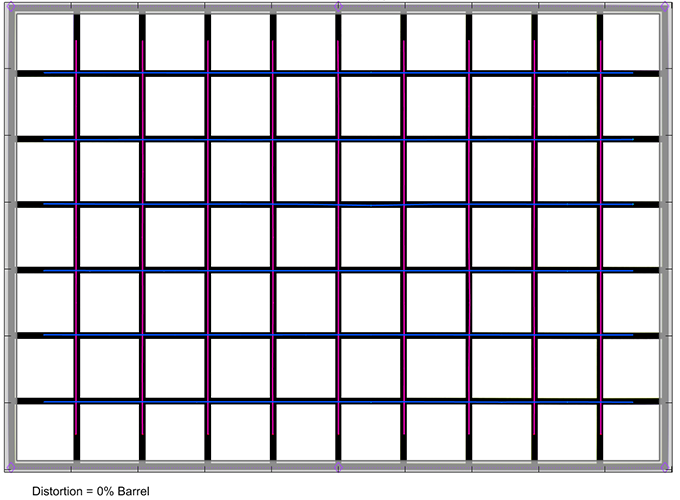|
Tokina FíRIN 100mm f/2.8 FE macro - Review / Test Report - Analysis |
|
Lens Reviews -
Sony Alpha (Full Format)
|
|
Page 2 of 3

Distortion
One of the advantages of re-using a DSLR design is the fact that these lenses are not quite as relying on digital image auto-correction.
The Tokina FíRIN 100mm f/2.8 FE macro is actually pretty much perfect in terms of image distortion.

Vignetting
The light falloff is very moderate for a full format lens. The uncorrected vignetting is visible at f/2.8 albeit it's far from being extreme here. Stopping down to f/4 reduces the issue and it's no longer relevant from f/5.6 onward. It's interesting that Tokina doesn't take too much advantage of the auto-correction option. With activate auto-correction, the light falloff is just slightly lower at large-aperture settings.

MTF (resolution)
In terms of resolution, the Tokina FíRIN 100mm f/2.8 FE macro has two souls. The broader center performance is pretty much outstanding straight from f/2.8 whereas the borders/corners aren't overly impressive. Stopping down to f/4 or f/5.6 maintains the great center quality. The outer image region improves only slightly. The best overall performance is reached around f/8 with good to very good borders and good corners. Diffraction effects are, as always, substantial at f/16 and heavy at f/22 thus unless you need the additional depth-of-field you should avoid these settings.
The field curvature is low - as you expect from a macro lens.
Below is a simplified summary of the formal findings. The chart shows line widths per picture height (LW/PH) which can be taken as a measure for sharpness.
If you want to know more about the MTF50 figures you may check out the corresponding Imatest Explanations

Chromatic Aberrations (CAs)
Lateral CAs are on a moderate level with an average CA pixel width of around 1.4px at the image borders. In critical scenes, you may spot this.
 Unfortunately, there's an aspect that has been carried over from the Tokina AF 100mm f/2.8 AT-X Pro macro - purple fringing (PF). PF is a blooming effect at extreme contrast transitions where adjacent pixels are saturated with ... well ... purple (really more violet in this case). Below (to the left) is an example crop where you can spot the effect. This is primarily an issue at f/2.8. Stopped down (as shown to the right), the fringing is gone.
Unfortunately, there's an aspect that has been carried over from the Tokina AF 100mm f/2.8 AT-X Pro macro - purple fringing (PF). PF is a blooming effect at extreme contrast transitions where adjacent pixels are saturated with ... well ... purple (really more violet in this case). Below (to the left) is an example crop where you can spot the effect. This is primarily an issue at f/2.8. Stopped down (as shown to the right), the fringing is gone.

Bokeh
When using a macro lens in its natural habitat, you are basically always operating with a very shallow depth-of-field. As such, the quality of the bokeh (rendering of the out-of-focus blur) is a rather critical characteristic.
The good news is that the Tokina FíRIN 100mm f/2.8 FE macro is excellent in this respect.
Out-of-focus highlights are nicely rendered with a very smooth inner disk. The circular shape of the discs is maintained at f/4 and the edgy aperture shape is just visible from f/5.6 onward.
 If we have a more detailed, look at an isolated & emphasized highlight, you may spot that the outer rim is actually decreasing in brightness which is the reason for the smoothness.
If we have a more detailed, look at an isolated & emphasized highlight, you may spot that the outer rim is actually decreasing in brightness which is the reason for the smoothness.
 The general rendering of the blur in the focus transition zones is also excellent - both in front as well as beyond the focus point.
The general rendering of the blur in the focus transition zones is also excellent - both in front as well as beyond the focus point.
 The circular shape of the discs is, as always, deteriorating towards the corners but, unlike on most lenses, the shape remains fairly ellipsoid.
The circular shape of the discs is, as always, deteriorating towards the corners but, unlike on most lenses, the shape remains fairly ellipsoid.
Bokeh Fringing / LoCA
Boheh fringing (sometimes referred to as LoCA) is an axial fringing effect with purplish halos in front of the focus point and greenish beyond. Only a handful of very expensive lenses correct the issue and, unsurprisingly, the Tokina is not among them. The fringing is visible at f/2.8 and reduced at f/4. Traces remain even at f/5.6 though.
|